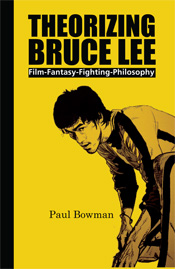Bruce Lee and Enter the Dragon – 40 years on
Posted by Dr Paul Bowman
Bruce Lee died on 20th July 1973, so this month sees the 40th anniversary of his death. It is also the 40th anniversary of the release of his most famous film, Enter the Dragon.

The US radio station ‘Voice of America‘ contacted me to talk about the ongoing significance of Bruce Lee forty years on. They asked me to comment because in 2010 I published one of the first book-length academic studies of the cultural significance of Bruce Lee.
Bruce Lee – in conversation with David DeForest on Voice of America
When I was writing the book between 2006 and 2008, there seemed to be very little ongoing interest in Bruce Lee in the West – although it was clear to me that you could see the influence of Bruce Lee in many things, especially Hollywood film fight choreography, and there was something of a renaissance of interest in Bruce Lee in Hong Kong and Chinese film. So I wrote the book more to make some academic points about the reasons why academics should take Bruce Lee seriously in the fields of cultural studies, media studies, postcolonial studies and in terms of his place in US identity and cultural politics. But bluntly, my argument was that Bruce Lee was not just a flash in the pan or a mere movie star. Rather, Bruce Lee was a big deal. He changed things – he changed people’s lives, the world over, and pushed a whole new set of concepts and life possibilities into the mainstream of Western popular culture: kung fu, Taoism, Shaolin monks, and more.
In 2013, there seems to be much more interest in Bruce Lee than there was even a year ago – and all over the world. I have had requests for interviews and articles from a very wide range of both US and Chinese media institutions, including ‘Radio China International’ and ‘Voice of America’ – both of which have audiences that are routinely in the hundreds of millions. A lot of new publications and films about Bruce Lee have appeared recently – including new ranges of Bruce Lee merchandise and even an advert for Johnny Walker whiskey that uses a CGI-enhanced Bruce Lee figure (aged to look as he might look today), aimed at the Chinese market.
Of course, many of these products and publications are clear attempts to cash in on the anniversary of Bruce Lee’s untimely death. But they also seem to have fanned the flames of a new interest in Bruce Lee, and I am very curious to learn what further developments we will see in the changing uses and abuses of Bruce Lee in different film, media, marketing, ideological and cultural contexts, the world over.

